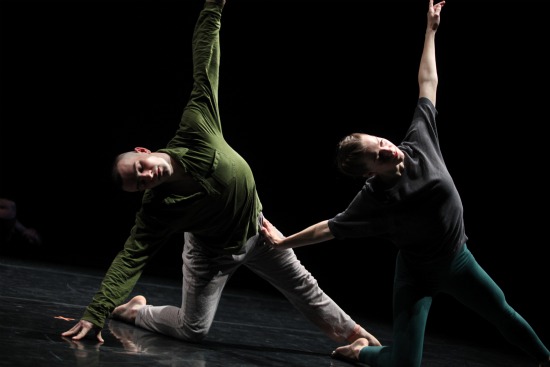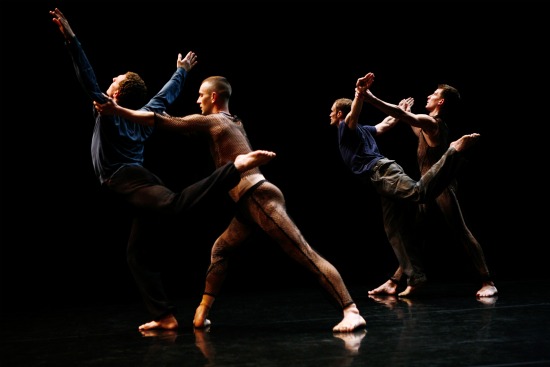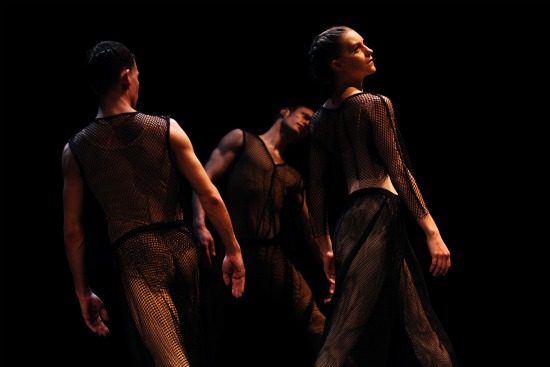The composer John Cage died suddenly in August 1992. In March 1993, his partner, choreographer Merce Cunningham, premiered a new dance, Doubletoss. These two facts resonated together for anyone watching the work’s first performances.
Cunningham said at the time that he had made two dances and merged them—ensuring that all 14 dancers knew both and using chance procedures to determine how the separate pieces intersected. With Susan Gallo, he devised two sets of costumes, both worn over flesh-colored leotards. Whenever any of the dancers were performing material from . . .let’s call it “A,” they dressed in variously colored pants and knitted cotton shirts. When the steps belonged to B, they put on garments of black fishnet. A scrim hung at the back of the stage, and in that narrow corridor, only those clad in black appeared.
I’m not sure whether or not Robert Swinston, former Director of Choreography for the now-nonexistent Merce Cunningham Dance company, followed the original costume rules in Four Walls/Doubletoss Interludes, the production that he presented at the Baryshnikov Arts Center (March 22 through 24) close to the 19th anniversary of Doubletoss. He was only able to assemble eight former Cunningham dancers for the project (of whom one, Daniel Squire, hadn’t danced with the company since 2009).
The new work is intriguing—both in its riskiness and in the vision it creates. Instead of being performed to Takehisa Kosugi’s original score, the piece is accompanied by the piano music that Cage composed for a dance-play that Cunningham wrote and choreographed in the summer of 1944 at Perry-Mansfield in Steamboat Springs, Colorado (the later-famous actresses Julie Harris and Leora Dana played roles in it).
Baryshnikov had hoped that Swinston and Cunningham dancers could recreate Four Walls, a poetic tragedy (including two Greekish choruses) about an American family. That turned out to be impossible, and a new way of bringing Cage and Cunningham together again emerged. Cage’s score lasts 55 minutes, which necessitated changes in Cunningham’s 1993 dance (30 minutes long). Swinston slowed some passages down, had the wonderful pianist Alexei Lubimov play the opening of Four Walls as an overture, and added choreography drawn from notes that Cunningham made in relation to Doubletoss (but didn’t use).
This Doubletoss —both diminished and augmented—is haunted by the ghost of its predecessor and is in itself haunting. The smaller company, dancing in an intimate, non-proscenium space, gives the impression of a closely bonded little society. When Brandon Collwes performs the slowed-down opening solo—with Joe Levasseur’s beautiful lighting casting his shadow on the back wall—he seems to take forever to bend forward and curl into a ball. You watch the hand that he slowly extends along the floor as if it were a major event. It’s a shock when Jennifer Goggans leaps and spins in, wheeling her arms—a veritable tornado. She stops to put a hand on Collwes’s shoulder and leaves. Whew! The lights go out for a second or two.
Cage’s music, played only on the white keys, is full of silences (originally, I believe, designed for the play’s text to fill), and—although it can on occasion be turbulent—it makes use of simple repeating patterns and single notes dropped into quietness. The dance, too, has iterated motions and motifs. Daniel Madoff, standing in place, keeps making quick half turns. At one point paired dancers assist each other gently and carefully—a hand clasp here, a counterbalance there. Collwes assists Madoff; Dylan Crossman steadies Squire. Goggans and Krista Nelson work together, as do Jamie Scott and Melissa Toogood. One person in each couple wears black, and, from time to time, those in the net garments step away from their partners to dance a few steps on their own. Later in the dance, as I remember, the roles are reversed.
As expected in a Cunningham work, flurries of quick motion punctuate slowness and stillness. Those who happen to be behind the scrim often freeze. The twisting, tilting torsos; the flashing legs; the quick feet; the leaps, the alert gazes give the impression of people with minds as nimble and self-possessed as their bodies. Throughout Four Walls/Doubletoss Interludes, you’re aware of people deciding to lie down, sometimes curling into a fetal position, of people helping others—often unexpectedly or awkwardly. Goggans prowls the space to suddenly loud music; three men run in and pick her up; she arches her back. Madoff sits on the floor, knees bent in front of him. Goggans, then Toogood, come to him. Scott, too, I think. Nelson arrives and lifts Madoff’s feet off the floor; they fall back down. All four women get him onto his knees and walk him toward the edge of the performance space. He continues away on his own.
The interweaving of the people in colored clothes and the people veiled in black is unpredictable. When the cast was larger, I thought I detected a difference in movement quality between the A people and the B people, and a contrast existed between the actions of a few dancers and flocking groups. Yet, of course, when only eight dancers are involved, we see them more clearly as individuals, and that is a fine experience. The last two years of touring honed these superb dancers, even as it exhausted them. Collwes shows increased intensity in this new-old work, and Goggans continues to appear more and more present in Cunningham’ choreography.
Partway through Four Walls/Doubletoss Interludes, a high voice floats out from the balcony; it belongs to the unseen soprano Joélle Harvey, singing with unearthly clarity. The only word I can catch is “death.” Inevitably, I see the event as a palimpsest—beautiful and urgent in itself— through which Doubletoss and the feelings it engendered almost 20 years ago shimmer. This is what I wrote then: “Whatever formal explorations prompted this dance, it is impossible not to feel it as a reassurance that what we call death may simply be an opening in the space-time fabric, and that the dead and the living dance together on the same stage.”
The whole venture has interesting ramifications. Cunningham thrived on risk and unplanned intersections among dance, music, décor, as well as compositional strategies involving chance. The Events he staged in various spaces were assemblages of passages drawn from different dances and performed to new music. It would be wonderful to see “his” dancers find more ways to re-animate Merce’s great work. The question will be how far they, or anyone, dare go in terms of manipulating his heritage.




Nancy Dalva was kind enough to send me the words that Cunningham wrote to go with the soprano’s song. I thought I heard the word “death.” She thinks it might have been “defted” (a Mercian neologism?), as in the line “Sweet love sweet love my throat is gurgling/ The mystic mouth leads me so defted.” She also tactfully pointed out that I has mis-identified the composer of the score for the 1993 “Doubletoss” as Toshi Ichiyanagi. Credit for that score belongs to Takehisa Kosugi. My bad.